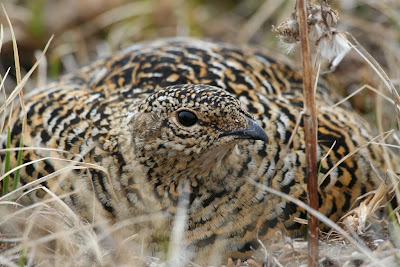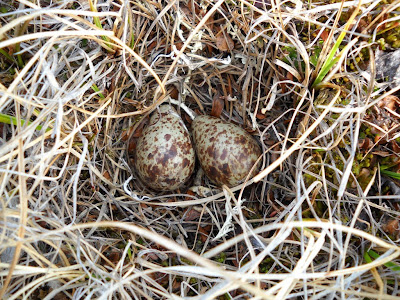 Sabine's Gull
Sabine's Gull
Last Saturday a local Inupiaq invited us on a pelagic trip to look for whales and birds. After boarding his boat, we were soon 4.5 miles out into the Chuckchi Sea and surrounded by Gray Whales, Bearded Seals and seabirds. Lewis has a lot of experience with whales being one of the local whaling captains so he was able to get us fantastic views of Gray Whales.

Here’s how close we got to view these majestic mammals. Words can’t explain how incredible it was to have them surface just feet away. We could feel the rumble as every whale took a deep breath before submerging back into the water to feed on the ocean floor.

These whales skim the top layer of sediment on the ocean floor returning to the surface straining the sediment through their baleen. This allows them to swallow only the bottom-dwelling invertebrates. As we watched them surfaced, we were able to see a lot of the sediment they brought up from the ocean floor.
After tearing ourselves away from the whales, we cruised along some of the sea ice in search of pelagic birds.

As we passed an iceberg we came across this group of Red Phalaropes. It took me a split second to remember that Red Phalaropes are actually pelagic birds. For the past two months I was studying their nesting habits on the tundra.

Here are the three most common Laridae off Barrow apart from Glaucous Gull. From left to right – Arctic Tern, Sabine’s Gull and Black-legged Kittiwake.

Arctic Terns are rather abundant in well…the Arctic. Here’s an oddly shaped iceberg with a couple dozen roosting on top.
I really want to get out on another pelagic but with only four full days remaining in Barrow, it’s unlikely. Perhaps next week, we will take a trip off Homer or Seward, Alaska.

 Cape Sugarbird
Cape Sugarbird

 Karoo Prinia
Karoo Prinia


 Here’s how close we got to view these majestic mammals. Words can’t explain how incredible it was to have them surface just feet away. We could feel the rumble as every whale took a deep breath before submerging back into the water to feed on the ocean floor.
Here’s how close we got to view these majestic mammals. Words can’t explain how incredible it was to have them surface just feet away. We could feel the rumble as every whale took a deep breath before submerging back into the water to feed on the ocean floor. These whales skim the top layer of sediment on the ocean floor returning to the surface straining the sediment through their baleen. This allows them to swallow only the bottom-dwelling invertebrates. As we watched them surfaced, we were able to see a lot of the sediment they brought up from the ocean floor.
These whales skim the top layer of sediment on the ocean floor returning to the surface straining the sediment through their baleen. This allows them to swallow only the bottom-dwelling invertebrates. As we watched them surfaced, we were able to see a lot of the sediment they brought up from the ocean floor. As we passed an iceberg we came across this group of Red Phalaropes. It took me a split second to remember that Red Phalaropes are actually pelagic birds. For the past two months I was studying their nesting habits on the tundra.
As we passed an iceberg we came across this group of Red Phalaropes. It took me a split second to remember that Red Phalaropes are actually pelagic birds. For the past two months I was studying their nesting habits on the tundra. Here are the three most common Laridae off Barrow apart from Glaucous Gull. From left to right – Arctic Tern, Sabine’s Gull and Black-legged Kittiwake.
Here are the three most common Laridae off Barrow apart from Glaucous Gull. From left to right – Arctic Tern, Sabine’s Gull and Black-legged Kittiwake. Arctic Terns are rather abundant in well…the Arctic. Here’s an oddly shaped iceberg with a couple dozen roosting on top.
Arctic Terns are rather abundant in well…the Arctic. Here’s an oddly shaped iceberg with a couple dozen roosting on top.













 Tomorrow will be the first whale festival of the year. I'm hoping to see some of it after nest searching. The blanket toss sounds interesting...
Tomorrow will be the first whale festival of the year. I'm hoping to see some of it after nest searching. The blanket toss sounds interesting...






+6-9-09.jpg)





 Here’s what one of our survey plots looked like – still a lot of snow. You can go from walking on bare tundra to snow up to your waist and occasionally you’ll find yourself sliding as you walk across puddles with iced bottoms.
Here’s what one of our survey plots looked like – still a lot of snow. You can go from walking on bare tundra to snow up to your waist and occasionally you’ll find yourself sliding as you walk across puddles with iced bottoms. It looks like we’re having orientation and protocols tomorrow so I’ll have some free time to bird around. Also, sorry if any of my blog posts are too dull...I've been running on very little sleep so it's hard to think what to write.
It looks like we’re having orientation and protocols tomorrow so I’ll have some free time to bird around. Also, sorry if any of my blog posts are too dull...I've been running on very little sleep so it's hard to think what to write.
 This is the Polar Bear Theater, which isn’t a theater. I still haven’t figured out why it’s called that. It’s pretty rough looking but so are the majority of the other houses in Barrow.
This is the Polar Bear Theater, which isn’t a theater. I still haven’t figured out why it’s called that. It’s pretty rough looking but so are the majority of the other houses in Barrow. The Arctic Ocean is still frozen over for the most part. Soon it will be open and birds will be migrating.
The Arctic Ocean is still frozen over for the most part. Soon it will be open and birds will be migrating. And last – looking down Stevenson’s Road near the Polar Bear Theater. This is what most of Barrow looks like.
And last – looking down Stevenson’s Road near the Polar Bear Theater. This is what most of Barrow looks like.






